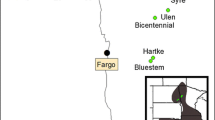Summary
-
1.
The British distribution ofP. maritima is continuous throughout the coastal regions, but is localised inland.
-
2.
The species is an aggregate of many growth-forms representing various combinations of characters. Growth habit ranges from the decumbent to the erect form, and five types have been described and figured.
-
3.
Plants derived from a single area on the east coast of Scotland were studied. This locality, though very limited in extent, was ecologically divided into two regions: (a) an exposed rock habitat; and (b) an adjoining grassy slope.
-
4.
Although the two habitats were not spatially isolated, population differentiation had occurred.
-
5.
In the wild, the environment had modified both populations considerably, but the effect was more marked in the case of the rock population.
-
6.
In culture the rock populations possessed a larger proportion of low-growing forms than did the grass population, but the latter contained no classified type which was not also present in the former.
-
7.
A phenotypic parallelism between the modificatory effect of the environment on the populations in the wild and the growth-forms present in the cultured populations was observed.
-
8.
It is possible that occasionally the phenotypical characteristics of growth-forms determine their survival, and some importance should be attached to the value of the several genotypes represented by a particular plienotype.
Similar content being viewed by others
Literature
Chevalier, A. (1923). “Rapports entre la végétation de la Normandie et du Massif Breton et celle de la Grande-Bretagne.”Bull. Soc. Bot. Fr. lxx, 598.
Geikie, J. (1894).The Great Ice Age. London.
Cregor, J. W. andSansome, F. W. (1927). “Experiments on the genetics of wild populations. Part I. Grasses.”Journ. Gen. xvii, No. 3.
Matthews, J. R. (1923). “The distribution of certain portions of the British flora. I. Plants restricted to England and Wales.”Ann. Bot. xxxvii, No. 146.
-(1924).Idem. “II. Plants restricted to Scotland, England and Wales.”Ibid. xxxvii, No. 142.
Reid, C. (1899).The Origin of the British Flora. London.
Reid, C. andReid, E. M. (1908). “The preglacial flora of Britain.”Joum. Linn. Soc. Bot. xxxviii, No. 265.
Ritchie, J. (1920).The Influence of Man on Animal Life in Scotland. Cambridge Univ. Press.
Salisbury, E. J. (August, 1929). “The biological equipment of species, in relation to competition.”Journ. Ecology, xvii.
Svenson, H. K. (1927). “Effects of post-pleistocene submergence.”Rhodora, xxix, Nos. 339, 340, 341, 342.
Turessoh, G. (1922). “The genotypical response of the plant species to the habitat.”Hereditas, iii, Häft 3.
Turrill, W. B. (1927). “The flora of St. Hilda.”Rept. Bot. Soc. and Exch. Club, viii, Part iii.
-(1928) “The flora of Foula.”Ibid. viii, Part v.
Wallace, A. R. (1892).Island Life. London.
Woodhead, T. W. (1924). “The age and composition of the Pennine peat.”Journ. Bot Lxii, No. 742.
-(1929). “History of the vegetation of the southern Pennines.”Journ. Ecology, xvii, No. 1.
Author information
Authors and Affiliations
Rights and permissions
About this article
Cite this article
Gregor, J.W. Experiments on the genetics of wild populations. Journ. of Gen. 22, 15–25 (1930). https://doi.org/10.1007/BF02983365
Issue Date:
DOI: https://doi.org/10.1007/BF02983365




